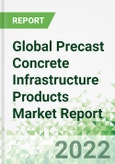Demand for precast concrete infrastructure products is projected to increase 8.1% per year to $5.9 billion in 2026. Gains will be driven by a significant influx of federal funding for road construction and other infrastructure products, as well as by ongoing trends away from traditional site-poured concrete in favor of precast products. By using precast products, project managers can reduce the time of projects and the need for more highly skilled labor, shortages of which continue.
The Infrastructure Investment & Jobs Act Will Boost Demand
Precast concrete product demand will be bolstered by the Infrastructure Investment & Jobs Act, which was passed in late 2021 and allocates $1 trillion (over eight years) for a wide array of infrastructure-related projects around the US. Many of these projects - including the renovation of bridges, railroads, roads, highways, public utility structures, and water and sewage facilities - will provide opportunities for precast concrete manufacturers.
Roads & Bridges Will Remain the Largest Application for Precast Concrete Products
Roads and bridges will remain the leading outlet for precast infrastructure products due to the nation’s massive stock of bridges, highways, and roads. Beyond the mere size of the US roads system, many of roads and bridges are far past due for repair, upgrade, or outright replacement, which will create significant market opportunities for products such as paving slabs and bridge components.
Precast Products Offer a Number of Advantages Compared to Competitive Options
The outlook for precast concrete infrastructure products is robust. While precast concrete products are generally more expensive than alternatives, they offer a number of advantages that allow them to effectively compete with other products, which include both manufactured infrastructure elements made of other materials and site-poured concrete.
Compared to other materials - such as plastic water handling products, metal pilings, and wood fencing - precast products offer much greater strength and durability. These performance characteristics give precast concrete products a strong competitive edge in infrastructure applications, where it is critical that construction products perform to their standards for extended periods of time.
Precast concrete products also benefit from their ability to save both time and labor costs. Poured-in-place concrete has long dominated in construction applications and will continue to do over the long term due its lower cost and familiarity among contractors. However, more project managers are becoming familiar with the advantages that precast products can offer, and more will continue to use these products at the expense of site-poured concrete, particularly in larger and time-sensitive projects or where labor shortages are of immediate concern.
Table of Contents
1. Executive Summary
Samples

LOADING...
Methodology

LOADING...








